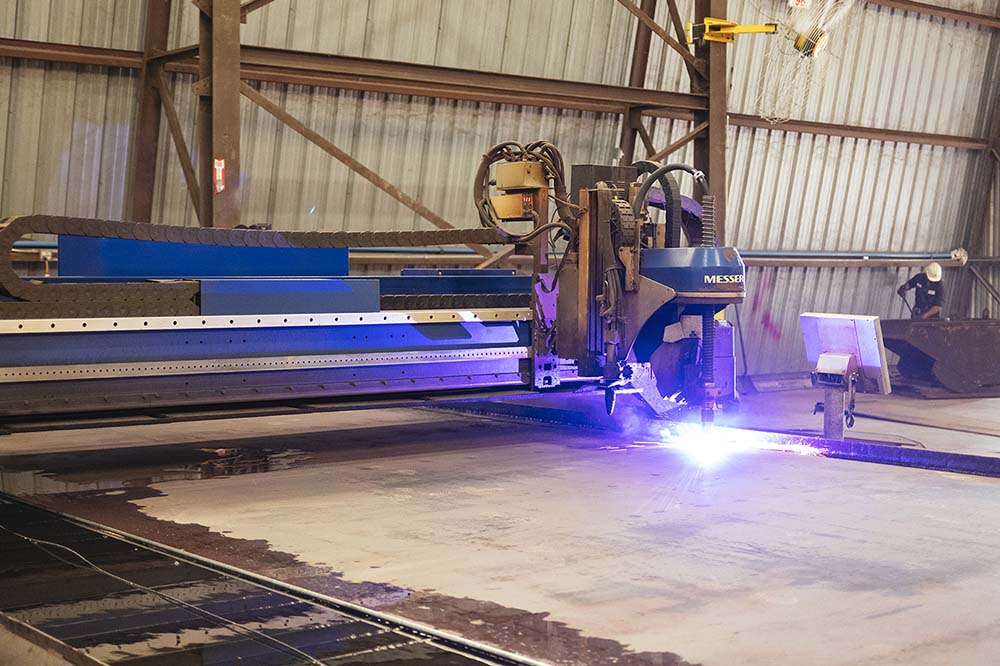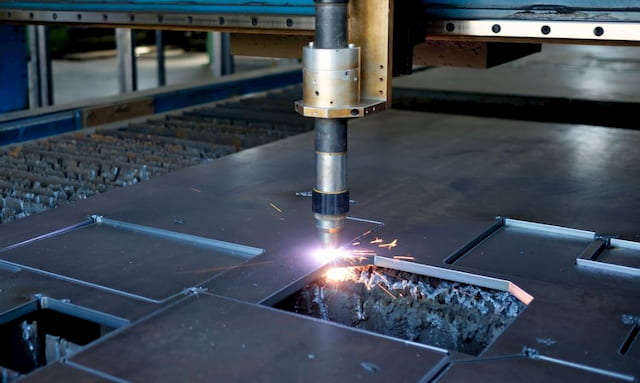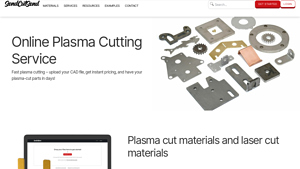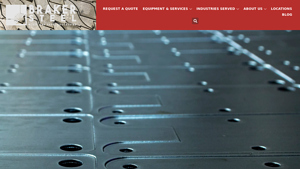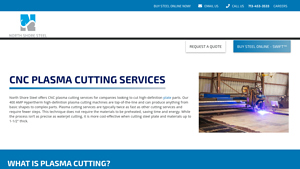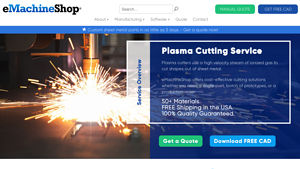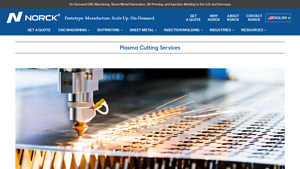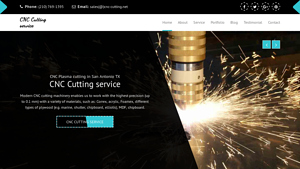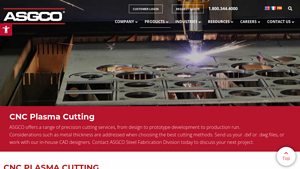Cnc Plasma Cutting Services Guide: Type, Cost, Top List…
Introduction: Navigating the Global Market for cnc plasma cutting services
Navigating the complexities of sourcing CNC plasma cutting services can pose significant challenges for B2B buyers. As companies across industries seek high-quality, precise metal fabrication solutions, understanding the nuances of plasma cutting—ranging from material compatibility to production speed—becomes essential. This guide offers a thorough insight into the offerings of CNC plasma cutting, detailing various types of services available, such as prototyping and high-volume production, alongside the critical applications in which they thrive.
Importantly, this resource equips international B2B buyers, particularly those in Africa, South America, the Middle East, and Europe—nations like Vietnam and Nigeria—with the knowledge required to make informed purchasing decisions. By assessing supplier capabilities, understanding cost structures, and exploring case studies of best practices, buyers will be prepared to identify partnerships that align with their operational demands.
Beyond just the technical specifications of plasma cutting, this guide emphasizes the importance of vetting suppliers based on quality certifications and logistical efficiency. As global supply chains become more interconnected, recognizing how to navigate potential hurdles in sourcing cutting services can provide a competitive edge in various market landscapes. By the end of this guide, you will be equipped with actionable insights to enhance your sourcing strategies in CNC plasma cutting services, ensuring your projects meet both budgetary and timeframe requirements.
Understanding cnc plasma cutting services Types and Variations
| Type Name | Key Distinguishing Features | Primary B2B Applications | Brief Pros & Cons for Buyers |
|---|---|---|---|
| 2-Axis Plasma | Standard configuration; cuts flat profiles efficiently | Large part fabrication; structural components | Pros: Cost-effective for thick materials. Cons: Limited to linear cuts. |
| 3-Axis Plasma | Adds rotational axis for angled cuts | Complex geometries; weld preparation | Pros: Reduces secondary machining costs. Cons: Higher initial investment than 2-axis. |
| High-Definition Plasma | Enhanced precision; finer cuts on thicker materials | Aerospace, automotive; high-tolerance parts | Pros: Superior accuracy and finish. Cons: Slower than traditional methods. |
| Automated Plasma | Integrates with robotic systems for enhanced workflow | Industrial large-scale operations | Pros: Increased production speed. Cons: Requires significant upfront costs. |
| Portable Plasma | Compact units meant for fieldwork | On-site fabrication; maintenance and repair | Pros: Versatile and accessible. Cons: Limited to thinner materials. |
What are the Key Characteristics of 2-Axis Plasma Cutting Services?
2-axis plasma cutting is the most conventional form, designed primarily for cutting flat parts from thick materials. This type uses a straightforward motion system to create clean, linear cuts quickly and efficiently. Ideal for fabricators needing basic shapes and profiles at an economical price, 2-axis plasma cutting is an excellent option for businesses focusing on large-scale production without intricate geometries. When sourcing this service, buyers should consider required material thickness and the volume of production to maximize cost-effectiveness.
How Does 3-Axis Plasma Cutting Enhance Fabrication Capabilities?
The 3-axis plasma cutting machine introduces an additional rotational axis, allowing users to execute angled cuts and intricate designs more easily. This functionality is particularly advantageous for companies specializing in complex weld preparation, as it minimizes the need for additional machining processes, ensuring parts fit precisely. Buyers looking for a cost-effective solution while maintaining high-quality standards should weigh the benefits of improved design flexibility against the higher initial setup costs and potential training requirements for operators.
What Advantages Does High-Definition Plasma Cutting Offer?
High-definition plasma cutting stands out due to its ability to deliver superior precision, making it suitable for applications requiring strict tolerances, such as in the aerospace and automotive industries. This process uses advanced technology to focus the plasma arc, resulting in a cleaner edge and a smoother finish. However, businesses must be aware that while high-definition plasma cutting may increase upfront costs, the long-term savings from reduced material waste and improved product quality can be significant.
Why Should You Consider Automated Plasma Cutting Solutions?
Automated plasma cutting systems utilize robotics to facilitate large-scale operations, making them ideal for manufacturers needing to optimize production times. These systems can handle high-volume output while delivering consistent quality. However, the initial investment for such advanced machinery can be substantial. Companies must assess their production needs and scalability plans to determine if the benefits justify the costs. Investing in automation can be pivotal for businesses looking to maintain a competitive edge in fast-paced markets.
What are the Benefits and Limitations of Portable Plasma Cutting?
Portable plasma cutters are designed for mobility, allowing for on-site work in various settings, including maintenance, repair, and fabrication. These tools are excellent for lighter materials and smaller jobs, making them versatile options for many fabricators. However, the thin material limitation should be noted, as they are not suitable for heavy-duty industrial applications. Businesses considering portable plasma services should evaluate their specific project requirements to ascertain fit and functionality under mobile constraints.
Key Industrial Applications of cnc plasma cutting services
| Industry/Sector | Specific Application of cnc plasma cutting services | Value/Benefit for the Business | Key Sourcing Considerations for this Application |
|---|---|---|---|
| Automotive Manufacturing | Cutting components like frames and brackets | Precision cutting reduces assembly time and costs | Evaluate the supplier’s certification standards and machinery capabilities |
| Construction | Fabrication of structural steel components | Enhances structural integrity and project timelines | Ensure material availability and compliance with local regulations |
| Aerospace | Manufacturing parts for aircraft structures | High efficiency and quality control | Confirm supplier’s experience with aerospace-grade materials and tolerances |
| Oil and Gas | Production of pipeline fittings and equipment | Cost-effective and fast fabrication | Assess the supply chain reliability and logistics for remote areas |
| Heavy Machinery | Custom parts fabrication for machinery repair | Improved uptime and operational efficiency | Require proof of capability to handle large, thick materials |
How is CNC Plasma Cutting Used in Automotive Manufacturing?
In the automotive manufacturing sector, CNC plasma cutting services are extensively used for cutting frames, brackets, and other critical components. This technique allows for high precision, which is vital in ensuring fitment and reducing assembly time. International B2B buyers should seek suppliers with advanced machinery and experience in automotive tolerances. Quality certifications are essential to mitigate risks associated with defective parts.
What is the Application of CNC Plasma Cutting in Construction?
CNC plasma cutting is vital in the construction industry for fabricating structural steel components such as beams and columns. This method offers rapid and accurate cutting, leading to enhanced structural integrity and faster project completions. For buyers in countries like Nigeria or South Africa, it’s crucial to source from suppliers who understand regional building codes and can provide materials that meet these standards.
How is CNC Plasma Cutting Beneficial to Aerospace?
Aerospace manufacturers rely on CNC plasma cutting for creating intricate parts, ensuring both quality control and efficiency. The ability to cut lightweight metals while maintaining precision is essential for performance and safety. International buyers must consider a supplier’s expertise with aerospace-grade materials and their ability to meet strict regulatory requirements when sourcing parts.
In What Ways Does CNC Plasma Cutting Aid Oil and Gas Industry?
In the oil and gas sector, CNC plasma cutting is used to fabricate pipeline fittings and other equipment, allowing for quick turnaround and cost efficiency. Reliability in remote locations is paramount, making it essential for businesses to evaluate suppliers’ logistics capabilities and their ability to adhere to safety standards specific to this industry.
Why is CNC Plasma Cutting Important for Heavy Machinery?
Custom parts fabrication via CNC plasma cutting is crucial for the heavy machinery industry, especially for repair services. This process improves downtime by allowing quick and precise part production, which translates to better operational efficiency. Buyers should seek out suppliers who can manage large and thick materials, as well as those who can demonstrate flexibility in producing custom orders to meet unique requirements.
3 Common User Pain Points for ‘cnc plasma cutting services’ & Their Solutions
Scenario 1: Difficulty in Achieving Tolerances and Precision in Cuts
The Problem: Many B2B buyers utilizing CNC plasma cutting services encounter frustrations related to the precision of cuts. This is particularly problematic for industries demanding high tolerance parts, such as aerospace or automotive. Plasma cutting can sometimes deliver inconsistent results, especially with thin or intricate designs, leading to costly reworks or rejects. Buyers may struggle with balancing speed and accuracy, often opting for faster production times at the expense of precision which jeopardizes the quality of their final products.
The Solution: To overcome this issue, buyers should thoroughly communicate their requirements regarding tolerances and specifications upfront. Engaging with service providers that offer advanced capabilities, such as 3-axis plasma cutting, can significantly enhance precision by allowing for angled and bevel cuts. Moreover, investing in prototype runs before proceeding to full-scale production can help identify potential issues with tolerances early in the process. It’s also prudent to verify certifications of the service providers, ensuring they adhere to industry standards such as ISO 9001:2015 which guarantees more consistent quality control.
Scenario 2: Long Lead Times Impacting Business Agility
The Problem: Lead times for parts created through CNC plasma cutting can sometimes be longer than anticipated, creating bottlenecks in production for B2B buyers. This is especially critical in fast-paced industries like construction, where timely delivery of parts influences project timelines and budgets. Delays in receiving essential components can lead to idle machinery, increased labor costs, and, ultimately, lost revenue.
The Solution: Buyers can alleviate lead-time issues by working with service providers that offer instant online quoting and rapid turnaround options. Choosing a supplier that can provide clear timelines when placing an order is crucial. Additionally, developing a strong relationship with the supplier can facilitate flexibility; for instance, working with a dedicated account manager may allow for expedited orders when urgent needs arise. Implementing a just-in-time (JIT) inventory system to maintain lower stock levels but rely on quick deliveries can also help in managing lead times effectively.
Scenario 3: Limited Material Choices and Compatibility Issues
The Problem: B2B buyers often face constraints related to material availability when using CNC plasma cutting services. While plasma cutting works well with conductive metals, many buyers require materials that could be more challenging to cut or process effectively. Furthermore, if a buyer needs specific coatings or characteristics, they may find that their chosen service does not offer compatibility with their project materials, resulting in increased costs or the need for additional processing steps.
The Solution: To mitigate these challenges, buyers should conduct comprehensive market research to identify CNC plasma cutting services that specialize in a broader range of materials. Prior to placing an order, they should clearly define material specifications, including treatment or finishing requirements, to ensure compatibility. Buyers may also benefit from consulting with engineers or material specialists to explore alternatives, such as utilizing hybrid cutting methods that combine plasma cutting with laser or water jet cutting, which can expand material options and reduce related costs. Furthermore, establishing long-term partnerships with suppliers who can source or accommodate specific materials can enhance consistency and quality across projects.
Strategic Material Selection Guide for cnc plasma cutting services
Which Materials are Most Commonly Used for CNC Plasma Cutting Services?
CNC plasma cutting services are ideal for various conductive metals, but some materials stand out due to their unique properties and suitability for specific applications. This analysis will delve into four common materials—mild steel, stainless steel, aluminum, and copper—exploring their key attributes, advantages, disadvantages, and considerations for international buyers.
What are the Key Properties of Mild Steel in CNC Plasma Cutting?
Mild steel, often referred to as low carbon steel, is widely used in CNC plasma cutting due to its excellent weldability and machinability. It can withstand high stress and loads, making it suitable for structural applications. The corrosion resistance of mild steel is limited, which can affect its longevity in certain environments.
Pros & Cons: Mild steel is cost-effective and readily available, with a relatively straightforward cutting process. However, it can be prone to corrosion if not treated, and its softer composition means that it can warp under high temperatures during the cutting process, impacting accuracy.
Impact on Application: Given its strength, mild steel is ideal for construction, automotive parts, and heavy machinery. Buyers should be aware that for optimal performance, particularly in humid or corrosive environments, protective coatings or treatments may be necessary.
Why Choose Stainless Steel for CNC Plasma Cutting?
Stainless steel is renowned for its corrosion resistance, making it a preferred choice for applications requiring hygiene and durability. Its composition, which includes chromium, provides a protective layer against rust and oxidation.
Pros & Cons: While stainless steel is more expensive than mild steel, its increased durability and resistance to corrosion justify the cost in many applications. The cutting process can be more complex due to its toughness, requiring higher-performance plasma cutting equipment.
Impact on Application: This material is widely used in food processing, pharmaceuticals, and marine environments. Buyers should ensure compliance with international standards, such as ASTM or ISO certifications, which may be critical depending on the end use.
What Advantages Does Aluminum Offer in CNC Plasma Cutting?
Aluminum, known for its lightweight and high strength-to-weight ratio, is a common choice for industries ranging from aerospace to automotive. Its thermal conductivity and machinability also contribute to its appeal in manufacturing.
Pros & Cons: Aluminum can be cut efficiently using plasma cutting; however, certain grades, particularly softer ones, can pose challenges due to melting during the cut. The material’s cost can also range from moderate to high, influenced by the grade selected.
Impact on Application: The aerospace and automotive industries often leverage aluminum for weight savings. Buyers must consider the specific alloy properties and potential international import duties affecting higher-priced grades of aluminum.
What are the Specific Benefits and Challenges of Using Copper?
Copper is another conductive metal widely used in manufacturing electrical components and various specialized applications. It offers superior electrical and thermal conductivity, making it crucial in electronic and electrical assemblies.
Pros & Cons: While copper can be plasma cut effectively, it tends to be more expensive and can generate extensive dross during cutting, potentially impacting the quality of finished products. The high thermal conductivity can also lead to warping if not managed correctly during the cutting process.
Impact on Application: Commonly utilized in electrical applications and plumbing, copper requires that buyers be mindful of quality standards and certifications relevant to their specific region, especially when dealing with electrical components across international borders.
Summary of Material Selection for CNC Plasma Cutting
| Material | Typical Use Case for cnc plasma cutting services | Key Advantage | Key Disadvantage/Limitation | Relative Cost (Low/Med/High) |
|---|---|---|---|---|
| Mild Steel | Structural components, automotive parts | Cost-effective and readily available | Prone to corrosion without treatment | Low |
| Stainless Steel | Food processing, pharmaceuticals, marine parts | Excellent corrosion resistance | Higher complexity in cutting, increased cost | High |
| Aluminum | Aerospace parts, automotive applications | Lightweight with good strength | Can melt if too soft, variable cost | Medium to High |
| Copper | Electrical components, plumbing | Superior electrical and thermal conductivity | Expensive and generates excess dross | High |
This strategic assessment of materials allows international B2B buyers to make informed decisions on plasma cutting based on their specific applications and requirements, ensuring compliance with industry standards and optimizing the efficiency of their manufacturing processes.
In-depth Look: Manufacturing Processes and Quality Assurance for cnc plasma cutting services
What Are the Main Stages of the Manufacturing Process for CNC Plasma Cutting Services?
The manufacturing process for CNC plasma cutting services involves several critical stages to ensure precision and efficiency. Understanding these stages helps B2B buyers make informed decisions when selecting a supplier for their needs.
Material Preparation: How Is It Done?
Material preparation is the foundation of the plasma cutting process. Suppliers typically start by sourcing high-quality conductive metals, including aluminum, mild steel, and stainless steel. In this stage, the chosen material is received, inspected for quality, and measured to confirm compliance with the specified dimensions of the CAD files submitted by customers. Precision at this initial stage is critical, as it sets the tone for the entire manufacturing process.
Once the materials are verified, they are cut to size using saws or shears. This step can also involve the removal of any rust, contaminants, or dual layers of material that could affect cutting quality. Effective collaboration between the supplier and buyer during material selection can help prevent issues that may arise later in the process.
What Techniques Are Used in the Forming Stage?
The core technique used in the forming stage of CNC plasma cutting is the application of high-velocity plasma jets to cut the prepared sheets of metal. The CNC plasma cutting system includes software that controls the motion of the plasma torch, allowing for intricate cuts and shapes to be achieved based on the specifications provided in the design files.
Various plasma cutting systems can be employed, such as 2-axis and 3-axis machines. 2-axis cutters are ideal for simple, flat cuts, while 3-axis machines offer additional versatility by allowing for tilt and angled cuts, which are essential for weld preparation and reducing the need for secondary machining operations.
How Does the Assembly Process Work?
Although plasma cutting primarily focuses on manufacturing flat parts, assembly may be required for complex components involving multiple finished parts. In such cases, parts may need to be precisely aligned and joined together using techniques such as welding or fastening. This stage often requires skilled personnel who understand the properties of different materials and their compatibility with various joining methods.
Post-cutting assembly is often guided by established industry standards to ensure that the finished product meets both functional and aesthetic requirements. Working closely with the supplier can help facilitate a smoother assembly process.
What Are the Common Finishing Techniques Used?
After assembly, parts may undergo various finishing processes to enhance durability, aesthetics, or both. Common finishing methods include deburring, which involves removing sharp edges and imperfections left behind by cutting; anodizing, which is mainly used for aluminum parts to increase corrosion resistance; and powder coating, which provides an attractive finish while also protecting the metal.
Depending on client specifications, additional treatments like plating and tumbling may be offered. It’s essential for buyers to discuss finishing options with the supplier to ensure that they select the best method for their specific application and requirements.
How Is Quality Assurance Ensured in CNC Plasma Cutting Services?
Quality assurance is paramount in CNC plasma cutting services, as even the smallest deviation can lead to significant functional issues. B2B buyers should look for suppliers that adhere to internationally recognized standards.
What International Standards Should B2B Buyers Look For?
When selecting a CNC plasma cutting service provider, it’s critical to verify adherence to international quality standards such as ISO 9001:2015, which outlines a framework for continual improvement and customer satisfaction.
Additionally, industry-specific certifications, such as CE marking for European markets or API certifications for the oil and gas industry, indicate that the supplier meets specific safety and quality benchmarks relevant to various sectors.
What Are the Key Quality Control Checkpoints?
Quality control checkpoints typically include:
-
Incoming Quality Control (IQC): At this initial stage, materials are inspected to ensure they meet predefined specifications.
-
In-Process Quality Control (IPQC): Throughout the plasma cutting process, regular inspections are mandatory to monitor the accuracy of cuts and ensure compliance with design tolerances.
-
Final Quality Control (FQC): After production, each part undergoes thorough testing and inspection before being shipped to the customer. This includes dimensional checks, visual inspections, and functional tests as required.
What Testing Methods Are Commonly Used?
Testing methods can vary based on the application but often include mechanical strength tests, dimensional accuracy assessments using tools like calipers and laser measuring devices, and surface finish evaluations. Additionally, suppliers may employ non-destructive testing (NDT) methods to identify potential flaws without damaging the parts.
How Can B2B Buyers Verify Supplier Quality Control?
Verification of a supplier’s quality control processes can be accomplished through several means:
What Role Do Audits and Reports Play?
Regularly scheduled audits of potential suppliers can reveal a great deal about their operational systems and quality assurance measures. B2B buyers should ask for audit reports from independent third parties or relevant industry bodies to assess compliance with necessary standards.
Should Buyers Request Third-Party Inspections?
Third-party inspections can be highly beneficial, especially for international buyers who want to ensure that the final product adheres to all specifications before shipment. Engaging a reputable firm to conduct onsite inspections adds an additional layer of confidence in the quality of the products being procured.
Are There Nuances for International Buyers?
International buyers from regions like Africa, South America, the Middle East, and Europe must be aware of specific nuances related to quality control in their respective markets. Understanding local regulations, customs requirements, and varying standards can aid in smooth procurement processes.
What Should Buyers Consider Regarding Certifications?
Some regions may require additional certifications, such as local safety standards or environmental compliance. It’s crucial for buyers to communicate clearly with suppliers to ensure that all requirements are met to prevent delays or compliance issues upon importation.
Overall, due diligence in understanding manufacturing processes and quality assurance mechanisms is essential for B2B buyers seeking CNC plasma cutting services. Partnering with reputable suppliers who prioritize these elements can lead to successful project outcomes and long-term relationships.
Practical Sourcing Guide: A Step-by-Step Checklist for ‘cnc plasma cutting services’
In the fast-paced and competitive world of B2B manufacturing, sourcing CNC plasma cutting services requires careful consideration and planning. This guide provides a structured checklist for international buyers, ensuring you make informed decisions, align your project specifications, and select reliable suppliers.
Step 1: Define Your Technical Specifications
Establishing clear technical requirements is crucial for effective communication with potential suppliers. Outline the dimensions, material types, thickness, and tolerances needed for your project. This clarity helps avoid delays and ensures the provider can meet your production needs effectively.
- Key considerations:
- Material types (e.g., steel, aluminum, copper).
- Required tolerances and finishes (e.g., anodizing, powder coating).
Step 2: Research Supplier Capabilities
Not all suppliers offer the same level of service or technology. Investigate potential suppliers’ capabilities, including their cutting technologies (2-axis vs. 3-axis), materials they can work with, and their production capacity. A well-rounded supplier should be able to handle both prototyping and large volume orders.
- Questions to ask:
- What types of CNC plasma cutting machines do you operate?
- Can you provide examples of similar projects you have completed?
Step 3: Evaluate Supplier Certifications
A reliable supplier should hold relevant industry certifications that indicate adherence to quality and safety standards. Certifications like ISO 9001 or ISO 13485 can provide assurance about their operational processes and product quality.
- Considerations:
- Look for suppliers with recognized industry certifications.
- Verify that they have processes in place for quality assurance.
Step 4: Request Samples or Proof of Work
Before committing to an order, it’s wise to request samples or previous work to evaluate the quality of their cuts and finishes. This step can save you potential headaches later by ensuring the supplier can meet your expectations.
- What to evaluate:
- Accuracy of cuts and adherence to specifications.
- Quality of surface finishes and material integrity.
Step 5: Understand Pricing Structures
Get detailed quotes from multiple suppliers to understand the pricing dynamics. Pricing may vary based on material, volume, and specific finishing services. Look for transparency in the pricing structure to avoid hidden costs down the line.
- Checklist for quotes:
- Request itemized quotes that detail each cost component (material, cutting, finishing).
- Ask about lead times and minimum order quantities.
Step 6: Check Reviews and References
Past customer experiences can provide valuable insights into a supplier’s reliability and service quality. Look for online reviews or ask for client references in industries similar to yours. This step can help you gauge their reputation in the market.
- Where to look:
- Industry-specific forums or review sites.
- Direct references from the supplier.
Step 7: Finalize Terms and Conditions
Once you have selected a supplier, ensure you agree on precise terms and conditions, including delivery timelines, payment terms, and post-production support. Clear agreements will help safeguard your interests and mitigate risks.
- Essential elements:
- Agree on production schedules and penalties for late delivery.
- Define terms for potential disputes or product rejections.
By following this checklist, international B2B buyers can streamline their sourcing process for CNC plasma cutting services, aligning their needs with the right suppliers effectively.
Comprehensive Cost and Pricing Analysis for cnc plasma cutting services Sourcing
What are the Key Cost Components for CNC Plasma Cutting Services?
Understanding the cost structure of CNC plasma cutting services is crucial for international B2B buyers. The main cost components typically include materials, labor, manufacturing overhead, tooling, quality control (QC), logistics, and profit margin.
-
Materials: Since plasma cutting is only effective for conductive metals, this significantly narrows down the raw material choices. Common materials include aluminum, mild steel, stainless steel, and copper. Material costs fluctuate based on market demand and availability, which can be influenced by geographic location.
-
Labor: Labor costs encompass the technicians and machine operators involved in operating CNC plasma cutting machines. Skilled labor is often a significant expense, with the cost varying based on the region. For buyers from Africa or South America, local labor rates may offer a cost advantage compared to suppliers in Europe and North America.
-
Manufacturing Overhead: This includes all indirect manufacturing costs such as utilities, machine maintenance, and shop rent. Operating advanced CNC equipment tends to have high overhead costs, especially if running multiple shifts to meet demand.
-
Tooling: The initial investment in tooling and fixtures can be substantial. However, as production volumes increase, the cost per part decreases, making it essential to evaluate tooling costs across projected order quantities.
-
Quality Control (QC): Implementing rigorous QC measures ensures product reliability and compliance with specifications. This incurs additional costs but is vital for maintaining quality standards, especially critical in markets with strict industry regulations.
-
Logistics: Transporting finished goods adds to the overall cost. International shipping can be especially challenging, with factors like customs duties and tariffs influencing total logistics costs.
-
Margin: Lastly, the profit margin varies by supplier and is influenced by their operational efficiencies and market competition.
What Influences Pricing in CNC Plasma Cutting Services?
Multiple factors can influence pricing in CNC plasma cutting services, which are especially pertinent for international buyers.
-
Volume Minimums (MOQ): Bulk orders often lead to bulk discounts, making it essential for buyers to negotiate Minimum Order Quantities. Suppliers frequently provide better rates for larger quantities due to diminished setup and operational costs per unit.
-
Specifications and Customization: Custom designs may incur additional development costs. The complexity of the design and any specific tolerances required can affect both the pricing and lead times.
-
Material Types: The choice of material heavily impacts pricing dynamics. Certain metals like titanium may incur higher costs than more common materials like carbon steel.
-
Quality Certifications: Suppliers with ISO certifications typically charge a premium for their services due to the additional quality assurances, which is often necessary for industries like aerospace or medical.
-
Supplier Factors: The geographic location and reliability of your supplier can influence costs. Suppliers in developed regions may have higher costs due to labor and overhead expenses.
-
Incoterms: Understanding the Incoterms used in your agreement is critical. Terms like FOB (Free on Board) or CIF (Cost, Insurance, and Freight) dictate responsibilities and can significantly affect final pricing.
How Can Buyers Optimize Costs in CNC Plasma Cutting?
International B2B buyers can implement various strategies to enhance cost-efficiency when sourcing CNC plasma cutting services.
-
Negotiate Pricing: Engage in discussions with suppliers to renegotiate prices, especially if securing high volumes or a long-term partnership. Many suppliers are willing to offer better rates for reliable clients.
-
Evaluate Total Cost of Ownership (TCO): Consider not only the price per unit but also how design choices affect downstream costs like assembly, finishing, or warranty claims. High-quality cuts can lead to reduced rework and longer product lifespans.
-
Understand Pricing Nuances: Being aware of the fluctuating markets for raw materials, shipping fees, and currency variations can allow buyers to time their purchases strategically.
-
Investigate Local Suppliers: Check for regional suppliers who may offer lower costs labor-wise without sacrificing quality, particularly focusing on emerging markets like Nigeria or Vietnam for potential budget advantages.
-
Order in Bulk When Possible: This can optimize costs by reducing per-unit costs and enhancing negotiation power with suppliers.
By concentrating on these areas, international buyers can attain a competitive edge in sourcing CNC plasma cutting services while managing costs effectively. Always remember to conduct thorough market research and supplier assessment before making any procurement decisions.
Alternatives Analysis: Comparing cnc plasma cutting services With Other Solutions
Exploring Alternatives to CNC Plasma Cutting Services
In the realm of industrial fabrication, CNC plasma cutting services serve a vital role in efficiently producing parts from conductive metals. However, various scenarios may call for alternative methods that better fit specific requirements or constraints. This analysis contrasts CNC plasma cutting with laser cutting and waterjet cutting, providing actionable insights for B2B buyers.
| Comparison Aspect | Cnc Plasma Cutting Services | Laser Cutting Services | Waterjet Cutting Services |
|---|---|---|---|
| Performance | Good for thicker metals; speed decreases with thin materials | High precision; excels in detailed work, especially with thin materials | Cuts hard materials without thermal distortion; slower than laser for thin materials |
| Cost | Generally cost-effective for thick materials; moderate operational costs | Higher cost per hour but reduces material waste; expensive for setup | High operational costs; economical for large, complex parts |
| Ease of Implementation | Requires specific conductive materials and setup | Diverse material compatibility; requires skilled operators | Requires a more extensive setup; materials must be appropriately prepared |
| Maintenance | Regular maintenance needed for consumables; moderate frequency | Less frequent; cleaner operation reduces wear | Requires periodic checks on water filtration and pump systems |
| Best Use Case | Ideal for metal fabrication where high-speed cutting of thick materials is necessary | Best suited for intricate designs on a variety of materials, including metals and plastics | Excellent for materials that cannot withstand heat, like composites and certain alloys |
Detailed Breakdown of Alternatives
Laser Cutting Services
Laser cutting is celebrated for its high precision and the ability to produce intricate designs, making it especially valuable in applications requiring tight tolerances. It operates by using a focused beam of light to melt or vaporize materials, delivering clean edges with minimal waste. However, the operational cost per cut can be higher than CNC plasma cutting, primarily due to the initial investment in equipment and the requirement for skilled operators to manage intricate settings. Laser cutting excels with thin materials but may be less efficient for projects involving thick metals, where plasma cutting may still hold an advantage.
Waterjet Cutting Services
Waterjet cutting utilizes high-pressure water mixed with an abrasive substance to slice through materials. This method is excellent for cutting sensitive materials, including composites and layered or coated substances, without the thermal deformation associated with laser or plasma cutting. Its versatility allows it to handle a wide range of materials from metals to stone. However, waterjet systems can be expensive to operate, and the slower cutting speeds may not make it ideal for high-volume production. It’s most beneficial for complex shapes and when the cuts must remain free of heat-affected zones.
Conclusion: Choosing the Right Cutting Solution
For B2B buyers considering their machining and fabrication requirements, the choice between CNC plasma cutting, laser cutting, and waterjet cutting hinges on specific project needs. Assessing critical factors such as material type, thickness, design complexity, budget constraints, and volume requirements will guide manufacturers in selecting the right option. Engaging in consultations with service providers can further inform these decisions, ensuring that the chosen method aligns with both operational capabilities and project goals.
Essential Technical Properties and Trade Terminology for cnc plasma cutting services
CNC plasma cutting is a vital service utilized in various industries, requiring an understanding of both technical specifications and trade terminology. This guide outlines the critical properties and common terms relevant to B2B buyers, facilitating informed decision-making.
What Are the Critical Technical Specifications for CNC Plasma Cutting Services?
Material Grade and Composition
The type of material selected for plasma cutting influences the quality and precision of the cut. Common materials include carbon steel, stainless steel, aluminum, and copper. Each material has a specific grade, which determines its properties such as strength, flexibility, and corrosion resistance. Understanding material grades is crucial for ensuring the final product meets performance specifications.
Thickness Tolerance
Thickness tolerance refers to the permissible variation in the thickness of the material being cut. In B2B applications, maintaining tight tolerances is essential because small discrepancies can result in misfitting components, increased waste, or additional machining costs. Standards are often specified as part of project requirements, guiding buyers in material selection that aligns with design precision.
Cutting Speed and Quality
Cutting speed impacts production efficiency, with faster cuts usually translating to lower costs. However, the speed must be balanced with cut quality, particularly when intricate designs or finishes are involved. Understanding how plasma cutting speed affects the final part is key for buyers seeking to optimize deliverables while managing costs.
Finish and Post-Processing Requirements
The final surface finish of plasma-cut parts is influenced by the method used and may necessitate additional post-processing, such as deburring or coating. Buyers should be aware of these requirements to ensure the produced parts meet the aesthetic and functional needs of their project. Assessing vendors for their finishing capabilities can enhance overall product quality.
Custom Tolerances and Specifications
Different applications may require custom tolerances and specifications tailored to specific performance requirements. Suppliers offering flexibility in their fabrication processes can provide a significant advantage, allowing B2B buyers to find solutions that fit unique project needs without sacrificing quality.
What Is the Importance of Common Trade Terminology in CNC Plasma Cutting Services?
OEM (Original Equipment Manufacturer)
This term refers to companies that manufacture products or components to be sold under another company’s brand. Understanding OEM relationships helps B2B buyers secure quality components that meet their specifications and can significantly affect supply chain dynamics.
MOQ (Minimum Order Quantity)
MOQ indicates the smallest quantity that a supplier is willing to sell. This term is especially relevant for plasma cutting services, as lower MOQs can benefit startups or smaller businesses looking for prototype cutting without committing to large quantities. Recognizing MOQs helps buyers manage inventory and budget effectively.
RFQ (Request for Quotation)
An RFQ is a document used to invite suppliers to bid on a project. Including specific details about materials, specifications, and quantities allows suppliers to provide accurate pricing. For B2B buyers, crafting a comprehensive RFQ can streamline the procurement process, ensuring that all necessary details are considered.
Incoterms (International Commercial Terms)
Incoterms are a set of rules defining the responsibilities of buyers and sellers in international transactions. Understanding these terms is crucial for B2B buyers to clarify shipping responsibilities, risk management, and duty obligations. Proper knowledge of Incoterms enhances procurement strategies, particularly for international sourcing.
CAD (Computer-Aided Design)
CAD files are crucial in the CNC plasma cutting process, allowing for precise designs to be uploaded and cut. B2B buyers should familiarize themselves with compatible file formats and the importance of CAD quality to ensure that their designs translate accurately into manufactured parts.
By mastering these technical properties and trade terminologies, B2B buyers can navigate the complexities of CNC plasma cutting services and make strategic decisions that align with their production goals.
Navigating Market Dynamics and Sourcing Trends in the cnc plasma cutting services Sector
What are the Current Trends Driving the CNC Plasma Cutting Services Market?
The CNC plasma cutting services sector is experiencing robust growth, primarily propelled by advancements in manufacturing technology and rising demand for custom fabrication solutions. Emerging technologies such as automated quoting engines and online service platforms have streamlined the procurement process, allowing buyers to receive instant pricing and lead times. For international B2B buyers, particularly in regions like Africa, South America, the Middle East, and Europe, online and multi-channel sourcing options have made it easier to access these services regardless of geographical constraints.
Another key trend is the increasing utilization of lightweight and durable materials, particularly in industries such as automotive and aerospace. Materials like aluminum, stainless steel, and other metals are increasingly favored for their strength-to-weight ratios, paired with plasma cutting’s efficiency in handling these materials. Additionally, businesses are focusing on rapid prototyping and low-volume production, as companies aim to reduce their time to market without compromising quality.
Moreover, the growing emphasis on cost efficiency is shaping sourcing dynamics. As end-users look for versatile options that integrate different processing technologies—such as plasma, laser, and water jet cutting—service providers that offer multi-faceted capabilities are gaining a competitive edge in the global market. This adaptability enhances project efficiency, thereby providing buyers significant value in both production time and outcome quality.
How Can Sustainability Influence B2B Sourcing in the CNC Plasma Cutting Services Sector?
Sustainability has become an increasingly pivotal factor in the sourcing decisions of international B2B buyers. Aiming to minimize environmental impact, companies are looking towards providers who embody ethical sourcing practices. In the plasma cutting industry, this means sourcing materials from suppliers who prioritize recycled or eco-friendly metals and who have certifications for sustainable practices.
The environmental impact of plasma cutting, while generally lower than other cutting methods, still warrants attention. The process produces waste such as metal slugs and fumes, so efficient waste management and energy-efficient machinery are critical. Buyers should consider partnering with service providers who implement measures to mitigate these impacts through proper waste disposal, emission controls, and energy-efficient production techniques.
Furthermore, certifications such as ISO 14001 (Environmental Management) demonstrate a service provider’s commitment to sustainability, assuring buyers that they are engaging in environmentally responsible practices. For international buyers, particularly from developing regions, aligning with suppliers who meet these ethical standards not only enhances their corporate social responsibility profile but also improves their competitive positioning in a global market where sustainability is increasingly scrutinized.
What has Driven the Evolution of the CNC Plasma Cutting Services?
Beginning as a niche fabrication method, CNC plasma cutting has evolved significantly since its inception. Initially utilized for heavy industrial applications, advancements in technology have made plasma cutting accessible to smaller manufacturers and custom shops. This evolution has been characterized by improvements in machine accuracy, speed, and a decrease in operational costs.
With the introduction of computer numerical control (CNC) technology, the process has become increasingly precise, enabling intricate designs that were previously challenging to achieve. The rise of computer software and CAD tools has further streamlined workflows, allowing for automated design modifications and quicker transition to production.
Today, CNC plasma cutting stands at the intersection of speed and versatility, making it essential across diverse sectors. As a result, manufacturers can respond to market demands more flexibly, whether for high-volume production runs or specialized, low-volume needs. This adaptability continues to fuel significant opportunities for international buyers seeking reliable, high-quality plasma cutting services.
Frequently Asked Questions (FAQs) for B2B Buyers of cnc plasma cutting services
1. How do I select the right CNC plasma cutting service for my needs?
Selecting the right CNC plasma cutting service involves evaluating several factors. Start by reviewing the service provider’s material capabilities, ensuring they can handle the specific conductive metals you require. Check their production speed and turnaround times, especially if you have tight deadlines. Additionally, consider their experience and reputation in the industry; looking for customer reviews and case studies can provide insights into the quality and reliability of their services. Lastly, don’t overlook the importance of their customer service and support, especially in navigating international shipping logistics.
2. What materials are most suitable for CNC plasma cutting?
CNC plasma cutting is typically compatible with various conductive metals, including mild steel, stainless steel, and aluminum. However, note that some materials, like soft aluminum, may not yield precise cuts due to melting during the cutting process. When choosing materials, consider the thickness as it influences both cutting speed and quality; thicker metals are cut more effectively with plasma technology. If your project involves composites or plastics, verify if the service provider offers alternative solutions like laser cutting or CNC routing.
3. What are the minimum order quantities (MOQ) for CNC plasma cutting services?
Minimum order quantities for CNC plasma cutting services vary significantly among providers. Some may allow low-volume orders or prototypes with no minimums, while others might impose a higher MOQ for cost efficiency. It’s essential to communicate your volume needs upfront when sourcing suppliers to ensure they can accommodate your requirements. If you’re looking for customization on smaller orders, inquire if the service provider offers discounts for prototyping or family pricing for nested components.
4. How do payment terms work in international transactions for CNC plasma cutting?
International payment terms can differ widely among CNC plasma cutting service providers. Typically, you can expect options like wire transfers, letters of credit, or payment terms that allow for partial payments upfront with the balance upon delivery. Ensure to discuss all fees related to international transactions, including currency conversion and any additional tariffs that may apply when goods cross borders. Establish clear communication regarding these terms to avoid misunderstandings and ensure smooth project execution.
5. What quality assurance (QA) practices should I look for in a CNC plasma cutting provider?
When evaluating a CNC plasma cutting service, it’s critical to assess their QA practices as they can significantly impact the product quality. Look for certifications such as ISO 9001, which indicates adherence to international quality management standards. A robust QA process should include material inspections, regular maintenance of machines, and thorough testing of finished products. Request information about their QA procedures, including how defects and rework are handled, to ensure your expectations for quality are met.
6. How can I ensure timely logistics for my plasma-cut components from international suppliers?
To ensure timely logistics for your plasma-cut components, first discuss shipping timelines with your supplier and include them in your project planning. Opt for suppliers that offer reliable international shipping options, including tracking capabilities. It’s also advisable to familiarize yourself with potential customs challenges or delays typical for your region. Establishing a good relationship with the logistics partner can facilitate smoother processes and we recommend a clear specification of shipping terms and responsibilities in your contract.
7. How does customization work for CNC plasma cutting projects?
Customization in CNC plasma cutting projects is typically accomplished through a detailed design process. You’ll need to provide your CAD files in formats like DXF or DWG, which the supplier can then use to generate precise cuts according to your specifications. Discuss your customization needs early on, including any requirements related to dimensions, finishing options, and material selections. Many suppliers also offer design assistance, which can be beneficial if adjustments are needed based on manufacturability or cost considerations.
8. What are the advantages and disadvantages of using CNC plasma cutting compared to other methods?
CNC plasma cutting offers several advantages, such as faster processing speeds for thick materials and lower operational costs compared to laser cutting. It’s ideal for producing parts that require bevel cuts for welding applications. However, plasma cutting may not provide the same level of precision for intricate designs as laser cutting does, particularly with thin materials. Assess your project requirements and consider factors like the desired cut quality, material thickness, and cost when comparing plasma cutting to alternatives like laser or waterjet cutting.
Important Disclaimer & Terms of Use
⚠️ Important Disclaimer
The information provided in this guide, including content regarding manufacturers, technical specifications, and market analysis, is for informational and educational purposes only. It does not constitute professional procurement advice, financial advice, or legal advice.
While we have made every effort to ensure the accuracy and timeliness of the information, we are not responsible for any errors, omissions, or outdated information. Market conditions, company details, and technical standards are subject to change.
B2B buyers must conduct their own independent and thorough due diligence before making any purchasing decisions. This includes contacting suppliers directly, verifying certifications, requesting samples, and seeking professional consultation. The risk of relying on any information in this guide is borne solely by the reader.
Top 7 Cnc Plasma Cutting Services Manufacturers & Suppliers List
1. SendCutsend – Online Plasma Cutting Services
Domain: sendcutsend.com
Registered: 2015 (10 years)
Introduction: Online plasma cutting services allowing customers to upload CAD files and receive instant pricing. Fast production timeline of 2-4 days for parts delivery. Plasma cutting available for conductive metals such as 5052 H32 Aluminum, Mild Steel, Polycarbonate, AR500, MDF, and Carbon Fiber in various thicknesses. Advantages include bevel cutting for welding purposes and cost-effectiveness for thick met…
2. Braker Steel – Core Metal Fabrication Services
Domain: steelplatefabrication.com
Registered: 2020 (5 years)
Introduction: Braker Steel offers a range of core metal fabrication services including: 1. X-Definition Plasma Cutting: Advanced CNC plasma cutting for steel flat parts (1/4″ to 2″ thickness). 2. Fiber Laser Cutting: Recently acquired Mitsubishi GXF 6KW fiber laser; cuts up to 1″ carbon and 1/2″ stainless plate with a 60″x120″ bed size. 3. CNC Plate Bending/Forming: Precision CNC press brake equipment for bendi…
3. North Shore Steel – CNC Plasma Cutting Services
Domain: nssco.com
Registered: 1996 (29 years)
Introduction: North Shore Steel offers CNC plasma cutting services using 400 AMP Hypertherm high-definition plasma cutting machines. The services allow cutting of high-definition plate parts, from basic shapes to complex designs, typically twice as fast as other cutting services without the need for preheating materials. The CNC plasma cutting is capable of cutting materials up to 1-1/2″ thick and is more cost-…
4. eMachineShop – Plasma Cutting Service
Domain: emachineshop.com
Registered: 1999 (26 years)
Introduction: Service Overview: Plasma Cutting Service
– eMachineShop offers cost-effective cutting solutions for single parts, batch prototypes, or production orders.
– Capable of cutting any conductive metal.
– Fast turn times.
– No-contact process for easier workpiece handling.
– Can pierce thick materials quickly.
Key Features:
– 50+ materials available.
– 100% quality guaranteed.
– FREE shipping in the US…
5. Norck – High-Definition Plasma Cutting Services
Domain: norck.com
Registered: 2016 (9 years)
Introduction: Norck delivers expert plasma cutting services for manufacturers in industrial, construction, automotive, energy, and other sectors. Key features include:
– High-Definition Plasma Cutting: Clean, precise cuts with minimal heat distortion.
– Versatile Metal Cutting: Effective across a range of alloys and thicknesses.
– Automation & Nesting: Maximizes material use and reduces part costs.
– In…
6. CNC Cutting – Precision CNC Services
Domain: cnc-cutting.net
Registered: 2018 (7 years)
Introduction: CNC Cutting service in San Antonio TX offers precise CNC cutting services using modern machinery with precision up to 0.1 mm, working with materials such as Correx, acrylic, Foamex, various types of plywood (marine, shutter, chipboard, elliotis), MDF, and chipboard. Services include CNC Plasma cutting, CNC Router cutting, and CNC Laser cutting, catering to industries such as furniture manufacturin…
7. ASGCO – CNC Plasma Cutting Services
Domain: asgco.com
Registered: 1996 (29 years)
Introduction: ASGCO offers CNC plasma cutting services with precision cutting capabilities for a range of materials. Key details include:
– Material Thickness: Up to 1 inch for carbon steel and up to 6.25 inches for stainless steel and aluminum.
– Table Capacity: 5ft x 10ft and also available capacity of 60″ x 120″.
– Software: Uses Razor Nest nesting software for efficient cutting.
– File Compatibility: Accept…
Strategic Sourcing Conclusion and Outlook for cnc plasma cutting services
In navigating the landscape of CNC plasma cutting services, strategic sourcing emerges as a vital approach for international B2B buyers seeking efficiency, cost-effectiveness, and reliability. By leveraging advanced technologies such as instant quoting engines and online ordering platforms, businesses can achieve quicker turnaround times while optimizing material costs. Notably, the variety of available materials—from aluminum to carbon steel—combined with the unique benefits of plasma cutting, such as its ability to handle thicker materials with speed, underscores the process’s versatility for diverse applications.
International buyers, particularly in African, South American, Middle Eastern, and European markets, should prioritize partnerships with suppliers who offer robust support, transparent pricing, and comprehensive service options. This not only ensures alignment with specific project requirements but also fosters innovation in product design and development.
As the demand for precision and efficiency continues to rise globally, investing in the right CNC plasma cutting partner can significantly enhance operational capabilities. We encourage B2B buyers to explore these strategic sourcing opportunities today, tapping into the growing potential of CNC plasma cutting to drive their projects forward with excellence.
